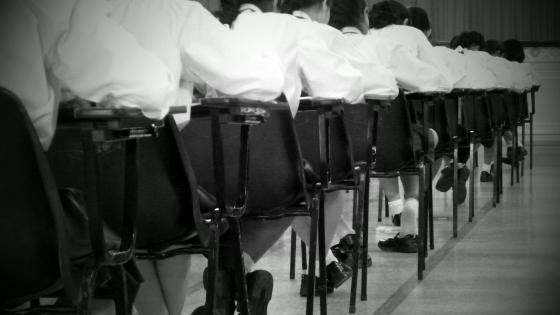In many labour market settings, organisations show a vertical hierarchical structure, with a large base of workers and some layers above with fewer positions, where the top layer consists of very few highly-rewarded positions. These hierarchical structures include features of a multi-stage elimination contest in which only the fittest survive to reach the final stages of the competition, where a few highly rewarded positions lie at the top.
It is known that men hold a larger portion of the highest-ranked occupations even within firms, in what is frequently referred to as the ‘glass ceiling effect’. Looking at the five highest-paid executives in each of a large number of US firms for 1992-1997, Bertrand and Hallock (2001) find that women represent only 2.5% of the sample (1,134 women out of 46,708 executives). In the last decade, behavioural differences between men and women have been put forward as a complementary explanation to understand gender differences in labour market outcomes. The idea is that the labour market is inherently competitive and thus, if there exist gender differences with respect to reactions to competitive environments, this may contribute to explaining differences in labour outcomes. For example, it has been shown that men and women react differently to competition. Gneezy et al. (2003), in a controlled environment, showed that even though under piece-rate incentives men and women showed no differences in performance, men indeed showed better performance than women when underlying incentives changed to a competitive scheme. However, it remains to be studied how this result evolves as competitive pressure increases.
Mathematics contest in Spain
Available field data to test for gender differences in performance in multi-stage competitions are scarce. A two-stage mathematics contest in the region of Madrid – where students compete to pass from stage 1 to stage 2, and then to be among the winners – offers an interesting opportunity to study the gender gap in performance as competitive pressure increases (Iriberri and Rey-Biel 2016). There are four independent contests, separated by the age of participants, where there are 10–16 year-old students. The two-stage contest in mathematics consists of a maths test of 25 multiple-choice questions to be completed in 90 minutes, where omitted questions score differently from wrongly answered questions. The first stage occurs at the school level, where there are fewer participants, and where the pool of participants is more familiar to the participants. The second stage occurs at the regional level, where the pool of participants is larger and consists of the best performers from stage 1, who are less familiar to the participants. These features make competitive pressure higher in the second stage than in the first.
Competitive pressure and gender differences in performance
We restrict the analysis to the balanced sample of participants who participate in both stages of the maths contest and measure the gender gap in performance. Female students have slightly better maths grades at school – 8.42 and 8.33 out of 10 for female and male students, respectively – although this difference is not significant. However, male participants perform better in both stages of the contest, and the gender difference in performance increases, for all age groups, from stage 1 to stage 2. By following the same individual participant across different stages, we find that the gender gap in performance increases from stage 1 to stage 2, from 4.9 to 7.2 exam points. This difference is explained by female participants leaving more omitted questions than boys and a greater relative increase in the number of omitted questions from stage 1 to stage 2. This gender difference in the number of omitted questions is consistent with previous findings in multiple-choice tests where there is penalisation for wrong answers or reward for omitted questions (Baldiga 2014).
Given the features of the contest, we are able to test for some heterogeneous effects based on the age of the participants, school characteristics, and ability. We find no heterogeneous effects based on the age of the participants or school characteristics, but the gender gap from stage 1 to stage 2 is not homogeneous along the distribution of ability. Interestingly, it is greater at top of the distribution of ability (Ellison and Swanson 2010).
Alternative explanations
Given that the data come from an existing contest, it is important to consider alternative explanations. An important concern is that of selection – that is, the male and female participants could come from different types of school. Although we indeed find that female participants are more likely to come from public, smaller, and lower quality schools, once we restrict the sample of participants to male and female participants who do not differ in these observable characteristics, we still find that the gender gap increases from stage 1 to stage 2. A second important concern is that of discrimination, as schools choose the participants who move to the second stage and this could lead them to bring to the second stage lower ability girls who, on top of that, may not be willing to compete. This alternative explanation is ruled out as we show that this selection is indeed based on performance in stage 1 of the contest and that male and female participants do not show differences in showing up in the second stage. Finally, stage 1 and stage 2 also show some differences in the difficulty of the questions, which could lead to the interpretation that the gender gap widens because girls respond worse to more difficult exams. However, we find that, once controlling for the difficulty of the question, the gender gap still increases from stage 1 to stage 2.
The underlying mechanism behind our results, unfortunately, remains unclear. One possibility is that male and female participants attach different values to winning in different stages, and accordingly, they may prepare differently for each of the stages. It could also be that parents and teachers have different expectations with respect to boys and girls and thus exercise differing degrees of pressure on them. Finally, it could also well be that there exists inherent gender differences in the ability to perform under the competitive pressure.
Conclusions
Female and male participants react differently to competitive pressure such that male participants outperform female participants in the two stages of a maths contest, and more importantly, this gap increases from the first to the second stage. This is indeed consistent with the overall hypothesis that men and women react differently to competition, which contributes to the explanation of why men and women have different labour market outcomes. In particular, it may be one of the reasons behind women occupying a smaller fraction of top positions in most institutions.
References
Baldiga, K (2014) “Gender differerences in willingness to guess”, Management Science, 60(2): 434–448.
Bertrand, M and K Hallock (2001) “The gender gap in top corporate jobs”, Industrial and Labor Relations Review, 55: 3–21.
Ellison, G and A Swanson (2010) “The gender gap in secondary school mathematics at high achievement levels: Evidence from the American Mathematics Competitions”, Journal of Economic Perspectives, 24(2): 109–28.
Gneezy, U, M Niederle and A Rustichini (2003) “Performance in competitive environments: Gender differences”, The Quarterly Journal of Economics, 118 (3):1049–1074.
Iriberri, N and P Rey Biel (2016) “Competitive pressure widens the gender gap in performance: Evidence from a two-stage competition in mathematics”, Barcelona GSE, Working Paper #879, February.



